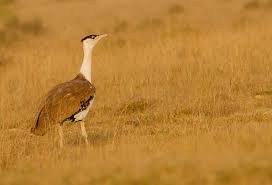Great Indian Bustards:

The Supreme Court intervened on behalf of the critically endangered Great Indian Bustards over the birds falling dead after colliding with power lines running through their dwindling natural habitats in Gujarat and Rajasthan.
- Scientific Name: Ardeotis nigriceps.
- Physical description: Black crown on the forehead contrasting with the pale neck and head. The body is brownish and the wings are marked with black, brown and grey.
- They feed on grass seeds, insects like grasshoppers and beetles, and sometimes even small rodents and reptiles.
- Distribution: India, effectively the only home of the bustards, now harbours less than 150 individuals in five States.
- Today, its population is confined mostly to Rajasthan and Gujarat. Small population also occur in Maharashtra, Karnataka, and Andhra Pradesh.
- It is the state bird of Rajasthan.
- Bustards generally favor flat open landscapes with minimal visual obstruction and disturbance, therefore adapt well in grasslands.
- They avoid grasses taller than themselves and dense scrub-like thickets.
- Listed in Schedule I of the Indian Wildlife (Protection )Act, 1972,
- Listed in Appendix I of CITES,
- Listed as Critically Endangered on the IUCN Red List.
- A Bench led by Chief Justice of India Sharad A. Bobde will examine on a priority basis whether overhead power cables can be replaced with underground ones to save one of the heaviest flying birds on the planet.
- The court found further that an alternative mechanism — to install flight bird diverters — to guide the birds away from the power lines would be expensive.




